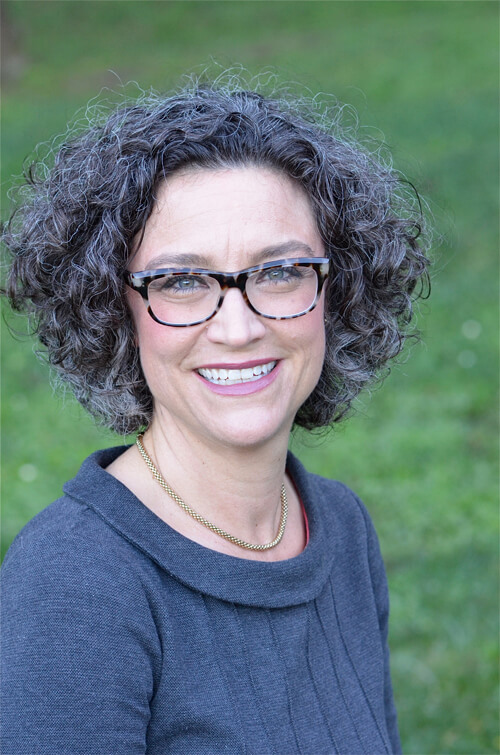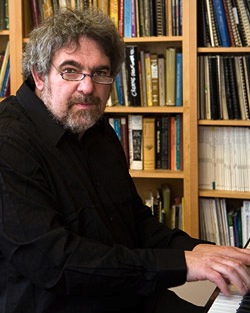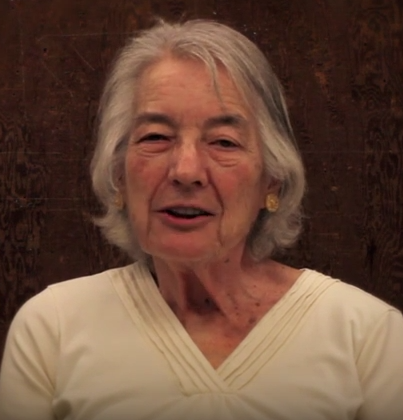
- From the University Librarian
- What is the value of UC Santa Cruz accepting the Other Minds Archive?
- An interview with Marion Taylor
- Grateful Dead Photography Exhibit
- The David Kirk Digital Scholarship Commons—Now open
- Bench Dedication
- Giving Day
 It has been a busy few months at the Library. A lot has happened, but I wanted to use this newsletter to highlight one particular success. As some of you may have heard or read, the Library recently was selected as the recipient of the Other Minds Archive. The Other Minds Archive is probably the most important collection of Western contemporary music of the 20th and 21st centuries in the United States. A large part of the Other Minds Archive consists of 4,000 audio and video recordings made between 1949 and 1995. Included are 30 years of high quality, one-of-a-kind recordings of Cabrillo Festival performances, as well as interviews with composers. Our local Cabrillo Festival is known to music lovers around the world and a source of great pride to Santa Cruz. It makes me particularly proud that through the acceptance of this gift, we are allowing these tapes to come home again.
It has been a busy few months at the Library. A lot has happened, but I wanted to use this newsletter to highlight one particular success. As some of you may have heard or read, the Library recently was selected as the recipient of the Other Minds Archive. The Other Minds Archive is probably the most important collection of Western contemporary music of the 20th and 21st centuries in the United States. A large part of the Other Minds Archive consists of 4,000 audio and video recordings made between 1949 and 1995. Included are 30 years of high quality, one-of-a-kind recordings of Cabrillo Festival performances, as well as interviews with composers. Our local Cabrillo Festival is known to music lovers around the world and a source of great pride to Santa Cruz. It makes me particularly proud that through the acceptance of this gift, we are allowing these tapes to come home again.
The UCSC Library is honored and pleased to take responsibility for preserving these treasures; we are looking forward to making sure they become accessible to the public. This will of course require digitizing the reel-to-reel tapes so that they will be available to students, faculty, researchers, and music lovers for many years to come. And we will be launching a number of efforts to seek funding for this important work.
I would like to personally thank Charles Amirkhanian and the Other Minds Organization for their trust in the Library, as well as our Head of Special Collections Beth Remak-Honnef for facilitating the gift. This archive is a wonderful addition to our collection and is poised to inspire many students for years to come.
Elizabeth Cowell
Richard L. Press University Librarian
Presidential Chair
What is the value of UC Santa Cruz accepting the Other Minds Archive?
by Larry Polansky
Any archive is historically important, but the Other Minds Archive in particular is an enormous and important resource not only for our  students and faculty, but for contemporary music scholars all over the world. West Coast experimental music had a major impact on the history of 20th-century American music, but archival information regarding this history is not easily available. The Other Minds Archive at UCSC—perhaps the single largest collection of material on contemporary music in California and the West—will change that. Once processed and made available to the public, this archive is bound to become a focal point, and more, a treasury of new information, histories, and ideas in contemporary music.
students and faculty, but for contemporary music scholars all over the world. West Coast experimental music had a major impact on the history of 20th-century American music, but archival information regarding this history is not easily available. The Other Minds Archive at UCSC—perhaps the single largest collection of material on contemporary music in California and the West—will change that. Once processed and made available to the public, this archive is bound to become a focal point, and more, a treasury of new information, histories, and ideas in contemporary music.
Charles Amirkhanian, composer, researcher, and radio activist for contemporary music, has archived many hours of music, performances, scores, and documentation. Conscious of the important history in which he played a vital role, he preserved an enormous amount of material which will keep music scholars enjoyably busy for a long time.
The Other Minds Archive at UC Santa Cruz will take its place among the elite group of major contemporary music collections, including the Getty Museum, the Ransom Collection at UT Austin, the Kitchen Archive in NYC, and libraries like the New York Public Library for the Performing Arts and the Library of Congress. It will happily join other such collections at UCSC—the Lou Harrison and Grateful Dead Archives, and the Cage Mycology Collection archive—making McHenry a focal point for scholarship, and UCSC a major attraction for graduate students, faculty, and in fact, the world of music.
An interview with Marion Taylor
by Joop Rubens
How did you get interested in music?
I attended a wonderful elementary school in Berkeley where music was highly valued. Most students played instruments; I started violin when I was seven. As I played in school orchestras and in string quartets, my interest in music only grew stronger, and I ultimately ended up playing with the Monterey County Symphony as well as the Santa Cruz Symphony. I was the Music Librarian at UC Santa Cruz from 1975 to 1993. I loved the job and enjoyed working with the faculty and talking with them about their needs, making sure we obtained books, scores, and recordings they wanted for teaching and research. I have been on the Board of the Cabrillo Festival of Contemporary Music since 1970.
Why do you think the Other Minds Archive and the included Cabrillo tapes in particular are of value to UC Santa Cruz?
 Every year the Cabrillo Festival was documented and recorded on tapes, which were preserved by Other Minds. And it is wonderful that those tapes are now coming to UC Santa Cruz. Documenting music is important and a lot of popular classical music is preserved, of course. But when a new piece of contemporary music is played, its value may be unpredictable. Is this the start of an impressive career, or not? Either way, if the music isn’t preserved, we risk losing critical pieces of this composer’s musical path to prominence. But if we document and archive it, years later, once we understand the talent of this composer, his works will be accessible and available for study
Every year the Cabrillo Festival was documented and recorded on tapes, which were preserved by Other Minds. And it is wonderful that those tapes are now coming to UC Santa Cruz. Documenting music is important and a lot of popular classical music is preserved, of course. But when a new piece of contemporary music is played, its value may be unpredictable. Is this the start of an impressive career, or not? Either way, if the music isn’t preserved, we risk losing critical pieces of this composer’s musical path to prominence. But if we document and archive it, years later, once we understand the talent of this composer, his works will be accessible and available for study
In the case of the Cabrillo Festival—a festival that is known to contemporary music lovers around the world—a lot of the pieces were hardly ever played elsewhere. So having access to all of the Festival’s tapes is extremely valuable, particularly of course to people who are interested in studying the music and the composers of this time. Again, you could not have predicted who would have risen to the top, or who would become a big name in the world of contemporary music. But these tapes let you go back in time and allow you to get a perspective on someone’s early sound, on what they composed before anyone had ever heard of them.
In the 1970s the Festival was quite experimental. The contemporary pieces were not always easy to appreciate and not everyone was ready for some of the music that was being played. By the late 1980s the composers were writing music which was accessible to a wider audience. The Festival’s popularity grew accordingly. But those early years were interesting, and the recordings will allow us to go back and dig through what was played back then. It is very possible that some of the less popular, earlier pieces were undervalued because they were merely ahead of their time.
At UC Santa Cruz, if students are interested in contemporary music, faculty could have them examine the music of the Cabrillo Festival and see what they think about it. They could have them follow the growth of a particular composer. You could also compare how the music of the Festival shifted under various musical directors. The directors are responsible for selecting the composers. And over time you could probably research how shifts in the style and the sound of the Festival evolved with the Festival’s leadership. The first music director of the Cabrillo Festival was Gerhard Samuel of the Oakland Symphony. He programmed many unusual pieces from the 19th and 20th centuries, often quite elaborate, and as a result after six years the Festival almost went broke. Once Dennis Russell Davies became the director in 1973, things changed. He started the tradition of a smaller orchestra mixing older music and more contemporary music, classic composers and new composers. His successor Marin Alsop has moved to programming only music by living composers.
The Cabrillo Festival is a wonderful event and having all of its recordings archived and processed at UC Santa Cruz is an incredible addition to the library’s Special Collections. It has been ten years since I lived in Santa Cruz, but although I am back in the East Bay now, I still come down to Santa Cruz for the Cabrillo Festival every year. The Festival is spread over two weekends, and so I drive down for those two weekends. The music is wonderful of course, but I also really like the sense of community you feel when you attend. The Festival has a family feeling. The open rehearsals, the street fair all make it a true festival and not just a series of concerts.
Grateful Dead Photography Exhibit
Nicholas Meriwether
Grateful Dead Archivist
The next Grateful Dead Archive exhibit opened on April 29 in McHenry Library’s Brittingham Family Foundation Dead Central. Calle d “Imagining the Dead: Photographs and Photographers of the Grateful Dead Archive, 1965–1995,” the exhibition features more than 200 images and artifacts drawn from every decade of the band’s career. As the ninth major exhibit to feature materials from the Archive, and the fifth to be held in Dead Central, this exhibition explores one of the most colorful and extensive parts of the Archive, the Photograph series.
d “Imagining the Dead: Photographs and Photographers of the Grateful Dead Archive, 1965–1995,” the exhibition features more than 200 images and artifacts drawn from every decade of the band’s career. As the ninth major exhibit to feature materials from the Archive, and the fifth to be held in Dead Central, this exhibition explores one of the most colorful and extensive parts of the Archive, the Photograph series.
Photography was a major part of the Grateful Dead phenomenon from the beginning, and this exhibit traces how the band encouraged and participated in the development of rock photography, and demonstrates the myriad of uses that photography played in their work. The 21 photographers featured in the exhibit cover every aspect of the band’s career, from their first experience in a professional recording studio to their final years of performing.
Professional photographers often found the band a remarkable subject, and the exhibit documents the work of several prominent photographers, including Jim Marshall, Gene Anthony, and Amalie Rothschild, but the exhibit also shows how the Dead fostered an environment that encouraged amateurs to become professionals, appealing to a broad cross-section of artists and would-be artists. Some of the best photos of the band came from talented fans, and many captured vital impressions of the broader scene.
That democratic inclusiveness was a hallmark of the Dead phenomenon, and it defines the photographs in the Archive. Visitors will be able to explore the often-surprising ways in which photography illuminates the Grateful Dead, from early promotional efforts to behind-the-scenes production. Many of the images have never been displayed publicly. The exhibit is free to the public, and open during normal library hours.
The David Kirk Digital Scholarship Commons—Now open
 The Digital Scholarship Commons serves as a catalyst for the creation, management, and delivery of digital content. We invite all members of the UCSC community to build innovative digital and web-based projects, find new intellectual partners, and collaborate on groundbreaking research.
The Digital Scholarship Commons serves as a catalyst for the creation, management, and delivery of digital content. We invite all members of the UCSC community to build innovative digital and web-based projects, find new intellectual partners, and collaborate on groundbreaking research.
Located on the ground floor of McHenry Library, the DSC is an open space for group and individual work. We provide access to high-end hardware and cutting-edge software on eight new workstations. We also offer workshops to foster scholarly experimentation.
Bench Dedication
Thanks to a generous donation from the UCSC Alumni Association Council, a bench dedication took place at McHenry Library on Friday, April 29th. Dozens of people attended the late afternoon ceremony under a bright, cloudless sky as University Librarian Elizabeth Cowell and Alumni Association Council President Donna Mekis unveiled the teak bench, with the inscription “In honor and appreciation of the generosity of the first 50 years of UCSC Alumni Association Life Members (1965 - 2015)”.
The UCSC Alumni Association serves the Santa Cruz campus and its alumni by encouraging UCSC alumni to participate in campus and society activities. Learn more about the Alumni Association by visiting their website at alumni.ucsc.edu/association/
On May 11th, alumni, friends, students, faculty, and staff of UC Santa Cruz came together in a way we never have before to support the great work of our university. The results were amazing: more than 3,000 gifts to 65 projects in a single day.
The Library’s project for the day was to support the digitization and preservation of over 30 years of Cabrillo Festival performance and interview tapes from the Other Minds Archive. We thank those who made a donation, which will allow us to start digitizing these tapes, to preserve them for future generations of scholars, musicians, and music lovers.
Contributors: Elizabeth Cowell, Joop Rubens, Nicholas G. Meriwether and Linda Hunt
Production: Linda Hunt
Copyediting: Mark Engel
Photography: Joop Rubens and Linda Hunt
Imaging the Dead Poster (c) Alexandra Fischer. Used with permission


 Santa Cruz, CA
Santa Cruz, CA



